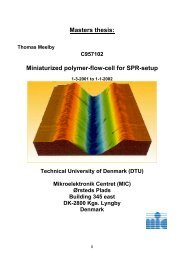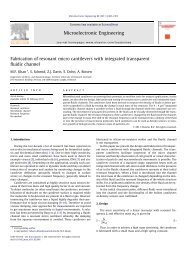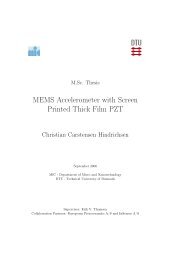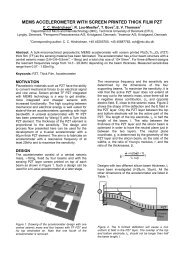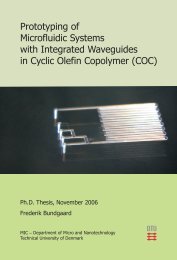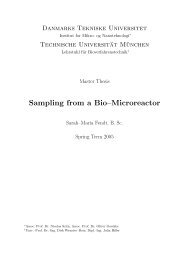Development of a Oxygen Sensor for Marine ... - DTU Nanotech
Development of a Oxygen Sensor for Marine ... - DTU Nanotech
Development of a Oxygen Sensor for Marine ... - DTU Nanotech
You also want an ePaper? Increase the reach of your titles
YUMPU automatically turns print PDFs into web optimized ePapers that Google loves.
5.2. BACK-END PROCESSING 45<br />
under each to improve adhesion.<br />
The 3 metals are added and patterned with 3 double rounds (First Ti, then<br />
the actual metal) <strong>of</strong> metalization and then lift-<strong>of</strong>f.<br />
5.2 Back-end Processing<br />
Once the cleanroom processes are done, there is still a few steps that have to<br />
be completed. These steps involves chemicals usually not found in a cleanroom,<br />
and the chip have to soak in them <strong>for</strong> a while, there<strong>for</strong>e they are done<br />
outside the cleanroom, also there is no real contamination danger <strong>for</strong> the<br />
electronics part <strong>of</strong> the wafer at this point.<br />
5.2.1 Packaging<br />
First the chip have to be packaged, this is done in three steps.<br />
The Flexprint and then Chip is glued to the middle layer <strong>of</strong> the PMMA. The<br />
Flexprint is attached first as to avoid getting glue onto the chip, however<br />
should it occur, the glue used (Super Attakgel) can be removed using<br />
ethanol, provided it is only a thin layer <strong>of</strong> glue.<br />
Figure 5.9: Flex print and Chip glued to the PMMA.<br />
Once the glue have dried (<strong>for</strong> 1-2 hours to be sure that it is completely<br />
dry), the flex print and the Au-contacts have to be connected. This can be<br />
done with either wirebonding, which will be the first choice, or by using a



